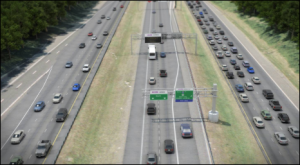by James A. Bacon
After years of anticipation, 95 Express Lanes opened its Interstate 95 HOT lane system to the public Sunday. Drivers get to use the lanes for free outside of rush hour, when the lanes remain restricted to high-occupancy vehicles (HOVs). Tolls will go into effect around the end of the month.
The nearly $1 billion project converts existing HOV lanes along I-95 into tolled HOT lanes while letting HOVs continue to drive for free, and extends the lanes to Stafford County. While the project won’t do much to shorten the commute for most commuters, it will give them an option when they place a high value on their time, said Matthew Click, vice president-national director of price-managed lanes for HNTB, an engineering firm that worked with 95 Express Lanes on the project.
“We expect most people to use them sometimes, when they really need to get somewhere and they need to get there now,” said Click in an interview with Bacon’s Rebellion. Click took issue with the description of HOT lanes as “Lexus” lanes. Tolled lanes provide a valuable option for less affluent drivers, he said. Someone making $25,000 a year could use the express lanes to pick up their kid at day care to avoid the $10-per-minute late charges. Plumbers might use the lanes to squeeze in an extra call, or taxi drivers an extra fare.
That was the predictable part of the interview, entirely in line with the business case for building HOT lanes. I have written extensively on this blog in support of HOT lanes. They come as close to a “win win” arrangement politically as it’s possible to devise in the transportation realm. They conform to the principle of “user pays,” they use market mechanisms to ration scarce capacity, and no one has to use them if they don’t want to.
Traffic forecasts. The conversation got much more interesting when we veered into the topic of demand for the HOT lanes. Will the volume of traffic on the Beltway and I-95, both of which are public-private partnerships, generate sufficient revenue to pay the back the billion-dollar investments?
The revenue forecasts for express lane projects are “very sensitive” to demand, Click said. “In an express lane situation, the competition is three feet away in the general-purpose non-tolled lane,” he said. The worse the level of service in the general lanes, the greater the traffic — and revenue — in the tolled lanes. An increase in demand for the tolled lanes does two things. It increases the number of cars being tolled, and it increases the toll rates, which are dynamically priced according to demand.
Click conceded that 495 traffic volumes are lower than forecast. “You’re seeing some initial birthing pains getting up and running,” he said. “It’s taking a little longer for volumes to ramp up during peak hours. … We’re seeing the impact of the recession of 2008., the greatest downturn in the economy since the Depression.” As the economy recovers, he said, he expects traffic demand to increase. The public-private partnership has a 75-year time horizon. “It’s warranted to give a couple or few years” for traffic volumes to recover.
But there are risks over the mid- to long-term as well, Click acknowledged. Demographic pressures may dampen Vehicle Miles Driven (VMT) overall and demand for HOT lanes specifically. Members of the Millennial Generation tend to drive less than predecessor generations. The population is aging, and the elderly don’t drive as much. Also, technology and the sharing economy are scrambling long-term demand forecasts.
“Imagine a future when people don’t own a car,” Click said. “I’ve got my mobile phone. I walk up to a subscription car, and it recognizes me. The car starts driving. I see my buddy Tim two blocks over. I pick him up. He bumps his phone to mine, and we split the fare. … Destructive creativity is really coming. It’s real.” And it means that VMT will not grow in the same linear relationship with population and the economy as in the past. “I see a future where [demand] is flat.”
Transformative technology. Click sees express lanes as the “precursor” of a world in 25 years “in which all lanes are priced.” The main barrier to such a future is not technology, it’s political will, he said. “The American public has a 50-year relationship with the fuel tax and the federal Interstate program. Peoples’ reaction to tolls is, ‘I’ve already paid.’ But I say, once you’ve paid off the mortgage on your house, you still have to fix the roof. You have to maintain the roads.” As fuel taxes decline and infrastructure degrades, express lanes will look better and better.
“We will fondly look back on express lanes as the first step toward the new transportation paradigm,” Click said. Charging drivers for usage of all roads on the basis of dynamic pricing will be the greatest driver of urban transformation since the invention of the elevator. “The next generation will change everything.”



